early flower, 1660's, galanthus from the Greek meaning milk white flower, nivalis from the meaning resembling snow. From the Etymology Dictionary
'If Candlemas Day is clear and bright
winter will have another bite.
If Candlemas Day brings cloud and rain
winter is gone and will not come again.'
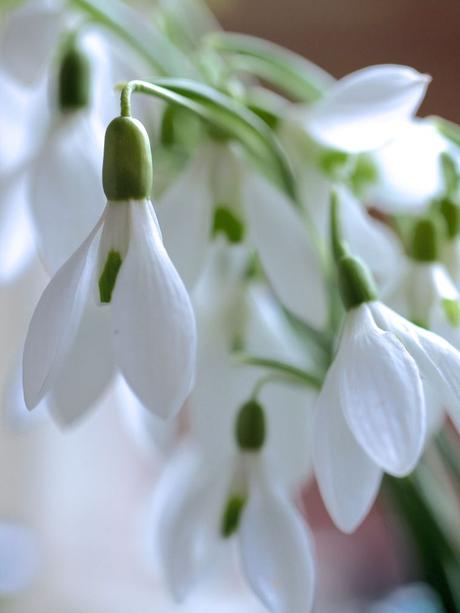 Today, February 2nd, is Candlemas Day in the church calendar - the day of Mary's purification, the presentation of Jesus in the Temple and the day on which the candles that are to be used in the next year of church services are blessed. In times gone by it was the custom to place a lighted candle in every window on Candlemas Day to bring light to the long dark winter - a tradition I think we would do well to revive today.Candlemas is also the day on which we are told we can predict the end of winter. Here in Suffolk, Candlemas has brought both cloud and rain, along with some very chilly temperatures. As I write tonight the fire is burning, my fairy lights are bringing a twinkling glow to the room and outside it is wet and chilly. After some refreshingly spring like days earlier this week I am holding out for the prediction that the worst is now behind us and spring is on its way. Looking at the actual forecast for next week however this seems very unlikely - I am keeping my fingers crossed that there will be some truth in the rhythm!
Today, February 2nd, is Candlemas Day in the church calendar - the day of Mary's purification, the presentation of Jesus in the Temple and the day on which the candles that are to be used in the next year of church services are blessed. In times gone by it was the custom to place a lighted candle in every window on Candlemas Day to bring light to the long dark winter - a tradition I think we would do well to revive today.Candlemas is also the day on which we are told we can predict the end of winter. Here in Suffolk, Candlemas has brought both cloud and rain, along with some very chilly temperatures. As I write tonight the fire is burning, my fairy lights are bringing a twinkling glow to the room and outside it is wet and chilly. After some refreshingly spring like days earlier this week I am holding out for the prediction that the worst is now behind us and spring is on its way. Looking at the actual forecast for next week however this seems very unlikely - I am keeping my fingers crossed that there will be some truth in the rhythm!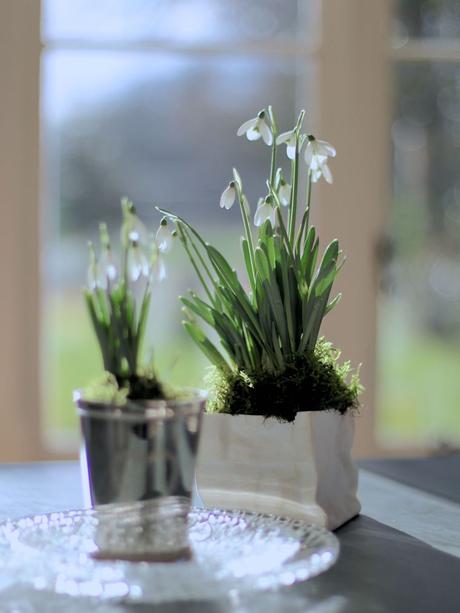 Whilst I have had snowdrops in flower since early January, I think of February as the best month for these dainty blooms. Alternatively know as Candlemas Bells and Fair Maids of February, it is now that the common snowdrop, galanthus nivalis, is appearing in carpets amongst the woodland areas of long established gardens and forests. This is the month to seek out the grand old houses with open gardens to enjoy the beautiful sight and scent of thousands of snowdrops flowering together. Even the likelihood of February snow will not daunt them - they are not known in France as perce-neige (snow piercers) for nothing. Coinciding with the very welcome spectacle of the snowdrops we also have the song of the blackbirds returning to our gardens - their first songs can be heard in late January or early February - another annual joy that marks the hope of the return to spring.
Whilst I have had snowdrops in flower since early January, I think of February as the best month for these dainty blooms. Alternatively know as Candlemas Bells and Fair Maids of February, it is now that the common snowdrop, galanthus nivalis, is appearing in carpets amongst the woodland areas of long established gardens and forests. This is the month to seek out the grand old houses with open gardens to enjoy the beautiful sight and scent of thousands of snowdrops flowering together. Even the likelihood of February snow will not daunt them - they are not known in France as perce-neige (snow piercers) for nothing. Coinciding with the very welcome spectacle of the snowdrops we also have the song of the blackbirds returning to our gardens - their first songs can be heard in late January or early February - another annual joy that marks the hope of the return to spring.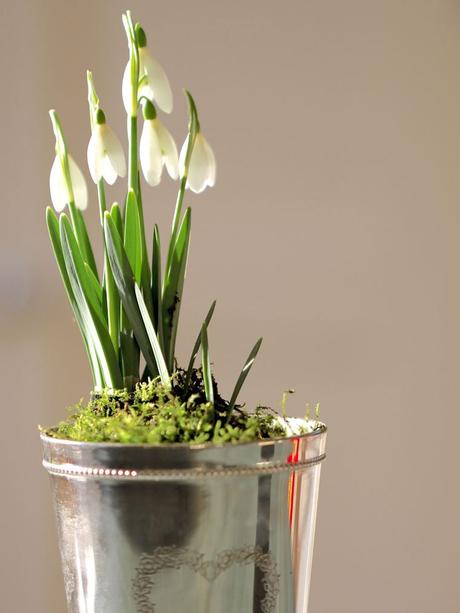 In a darker tradition snowdrops are known as the death flower. The Victorians believed that the snowdrop represented death and that it would bring bad luck to bring snowdrops inside. The snowdrop was, however, Prince Alberts favourite flower and Queen Victoria carried a small bouquet of snowdrops on their wedding day on 10th February 1840 - clearly she was not troubled by their sinister reputation. After her death on 22nd January 1901 her coffin was surrounded by white flowers which included snowdrops brought from Osborne House, the summer residence of Victoria and Albert on the Isle of White.
In a darker tradition snowdrops are known as the death flower. The Victorians believed that the snowdrop represented death and that it would bring bad luck to bring snowdrops inside. The snowdrop was, however, Prince Alberts favourite flower and Queen Victoria carried a small bouquet of snowdrops on their wedding day on 10th February 1840 - clearly she was not troubled by their sinister reputation. After her death on 22nd January 1901 her coffin was surrounded by white flowers which included snowdrops brought from Osborne House, the summer residence of Victoria and Albert on the Isle of White.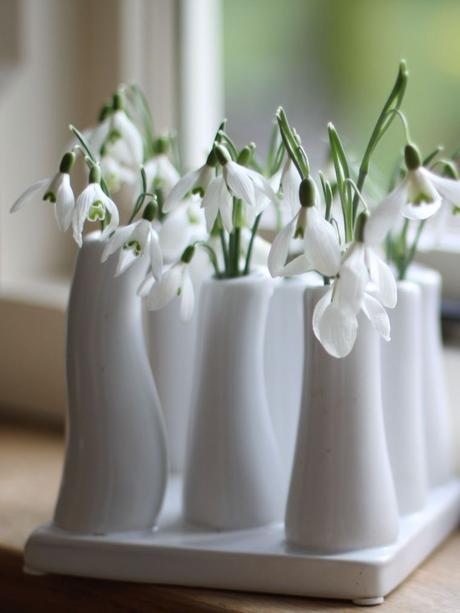 Personally I have no suspicions relating to any of the flowers that I can cut from my garden - all are loved and welcomed into my home. At this time of year rarely a day goes by when I do not have a little bunch of snowdrops cut to enjoy inside. Whilst it is a challenge not to spend time dreaming of spring and all the joys that it will bring, I am very conscious of the importance of enjoying what is here right now - the many snowdrops that are filling corners of my garden under deciduous trees, hellebores with their jewel like colours and the dancing catkins that are hanging from hazel, birch, hornbeam and alder trees and the beautiful shrub garrya 'James Roof'. When you add the joys of trailing ivy with its perfect berries, frosted topiary and a greenhouse filled with the scent of Paperwhites, February is clearly a month to embrace - all too quickly it will be over and the snowdrops will be just another item on my to do list - i.e. 'must divide clumps before the foliage dies away'.
Personally I have no suspicions relating to any of the flowers that I can cut from my garden - all are loved and welcomed into my home. At this time of year rarely a day goes by when I do not have a little bunch of snowdrops cut to enjoy inside. Whilst it is a challenge not to spend time dreaming of spring and all the joys that it will bring, I am very conscious of the importance of enjoying what is here right now - the many snowdrops that are filling corners of my garden under deciduous trees, hellebores with their jewel like colours and the dancing catkins that are hanging from hazel, birch, hornbeam and alder trees and the beautiful shrub garrya 'James Roof'. When you add the joys of trailing ivy with its perfect berries, frosted topiary and a greenhouse filled with the scent of Paperwhites, February is clearly a month to embrace - all too quickly it will be over and the snowdrops will be just another item on my to do list - i.e. 'must divide clumps before the foliage dies away'.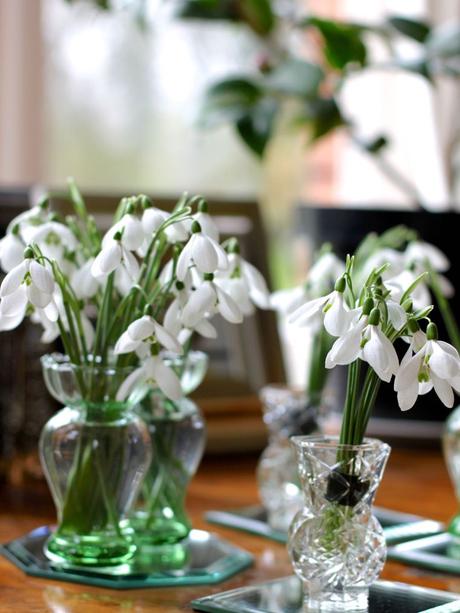 Whilst I do appreciate the galanthophile's passion for the various named varieties of snowdrops and the long flowering period that can extend from autumn well into spring, I have to admit that I do not share in this passion to collect unusual bulbs. For me the sight and scent of the mass flowering of the common single galanthus nivalis and double flore pleno in February provides all the romance and beauty that I seek. I often wonder how the red rose that has to be imported from warmer climates became the symbol of Valentines Day, when the fleeting beauty of these delicate snowdrops would represent love in this wintery season so much better.
Whilst I do appreciate the galanthophile's passion for the various named varieties of snowdrops and the long flowering period that can extend from autumn well into spring, I have to admit that I do not share in this passion to collect unusual bulbs. For me the sight and scent of the mass flowering of the common single galanthus nivalis and double flore pleno in February provides all the romance and beauty that I seek. I often wonder how the red rose that has to be imported from warmer climates became the symbol of Valentines Day, when the fleeting beauty of these delicate snowdrops would represent love in this wintery season so much better.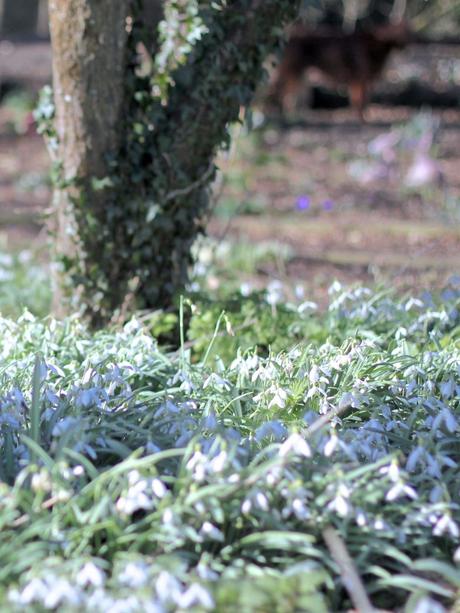 Snowdrops make a beautiful pairing with hellebores in the winter garden - both reach their peek of beauty at about the same time and enjoy much the same growing conditions. I wrote about my love of hellebores a couple of weeks ago - you can visit that post here - and since then I have added yet more varieties to my Spring Walk. Around the new hellebores I will be planting divided clumps of my snowdrops after they have finished flowering in March as nothing hides the bare soil surrounding a hellebore better than a skirt of snowdrops.
Snowdrops make a beautiful pairing with hellebores in the winter garden - both reach their peek of beauty at about the same time and enjoy much the same growing conditions. I wrote about my love of hellebores a couple of weeks ago - you can visit that post here - and since then I have added yet more varieties to my Spring Walk. Around the new hellebores I will be planting divided clumps of my snowdrops after they have finished flowering in March as nothing hides the bare soil surrounding a hellebore better than a skirt of snowdrops.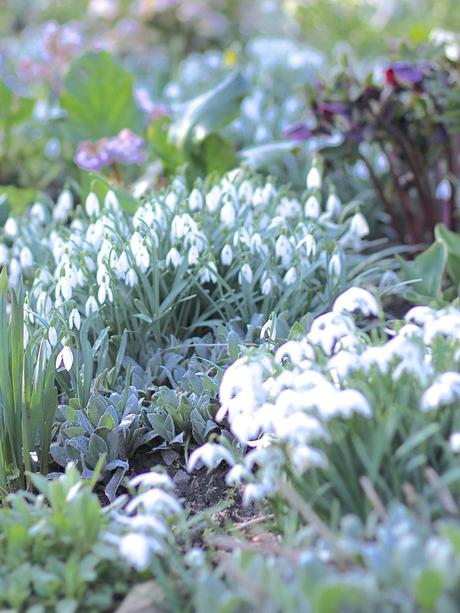 I have been blessed with a garden in this old rectory that is full of snowdrops, many growing in grass under trees in otherwise quiet corners that I only actively seek out at this time of year. Old Rectorys, like churchyards and monasteries are often blessed with huge swathes of snowdrops - were they planted in these religious places because their flowering time coincides with Candlemas I wonder, or were they already there in flower before these places were built and were protected and allowed to increase because their flowering coincided with Candlemas? In my developing Spring Walk where I grow the majority of my hellebores I am trying to increase the areas populated by snowdrops, so every year I devote a day or two to lifting and splitting clumps of bulbs. The smaller clumps are replanted under trees, shrubs and hellebores in this area with a handful of fish, blood & bone to help them recover from the ordeal of being moved. I have read that Beth Chatto did this every year in her beautiful garden and that is why her snowdrop display is so extensive today.
I have been blessed with a garden in this old rectory that is full of snowdrops, many growing in grass under trees in otherwise quiet corners that I only actively seek out at this time of year. Old Rectorys, like churchyards and monasteries are often blessed with huge swathes of snowdrops - were they planted in these religious places because their flowering time coincides with Candlemas I wonder, or were they already there in flower before these places were built and were protected and allowed to increase because their flowering coincided with Candlemas? In my developing Spring Walk where I grow the majority of my hellebores I am trying to increase the areas populated by snowdrops, so every year I devote a day or two to lifting and splitting clumps of bulbs. The smaller clumps are replanted under trees, shrubs and hellebores in this area with a handful of fish, blood & bone to help them recover from the ordeal of being moved. I have read that Beth Chatto did this every year in her beautiful garden and that is why her snowdrop display is so extensive today.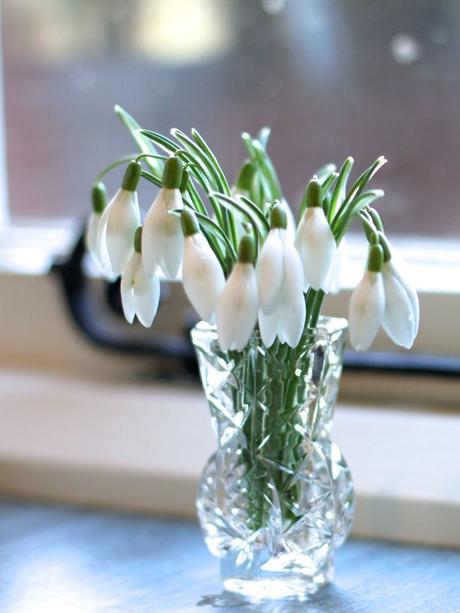 It is important not to plant snowdrops under evergreen trees - the permanent deep shade from these trees does not suit these tiny bulbs and they will be unlikely to survive - they are also not good in very wet situations. A woodland setting or the edges of a deciduous hedge are the ideal position. They will also do well in a partially shaded border. If you are splitting existing clumps I would advise that you replant the bulbs in a random manner - spacing small groups of bulbs deep into the border to give a feeling of depth. All too often snowdrops can be seen just edging a border in a manner that is most unnatural - in nature they spread themselves in pools rather than lines and to my eye this natural way is best. Current thinking suggests that it is best to split the clumps whilst the bulbs are completely dormant but this would only work in a garden where clumps are individualy marked year round. It is far more practical for me to split the bulbs 'in the green' as I have done for many years, when I can clearly see where they are and the impact that any new plantings will have on the border at the time that the snowdrops are to flower.
It is important not to plant snowdrops under evergreen trees - the permanent deep shade from these trees does not suit these tiny bulbs and they will be unlikely to survive - they are also not good in very wet situations. A woodland setting or the edges of a deciduous hedge are the ideal position. They will also do well in a partially shaded border. If you are splitting existing clumps I would advise that you replant the bulbs in a random manner - spacing small groups of bulbs deep into the border to give a feeling of depth. All too often snowdrops can be seen just edging a border in a manner that is most unnatural - in nature they spread themselves in pools rather than lines and to my eye this natural way is best. Current thinking suggests that it is best to split the clumps whilst the bulbs are completely dormant but this would only work in a garden where clumps are individualy marked year round. It is far more practical for me to split the bulbs 'in the green' as I have done for many years, when I can clearly see where they are and the impact that any new plantings will have on the border at the time that the snowdrops are to flower.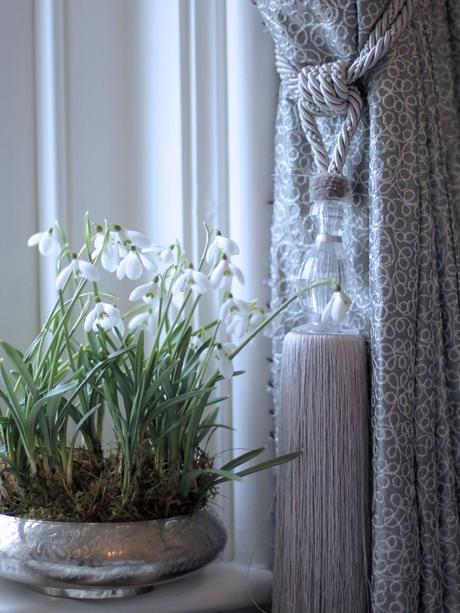 Sometimes I will lift a clump whilst it is still in flower and replant the bulbs in an indoor container - this silver bowl is a favourite. The flowers will last a little longer than they do if cut for a vase, but the bulbs must be kept in a cool room - snowdrops are a flower of the winter after all - and the flowers will brown very quickly in a warm situation. In truth, however pretty these indoor vignettes are, snowdrops are happiest out in the garden where they will flower for weeks until a warm spring day towards the end of February will send them retreating back to the safety of the soil for the summer months, waiting their turn to shine again next winter. As with all bulbs, do not remove the leaves until they have turned brown and come away easily. In areas where they are growing through the grass, I have a strict rule of not cutting the grass until May to allow the bulbs time to replenish themselves before their leaves are removed.
Sometimes I will lift a clump whilst it is still in flower and replant the bulbs in an indoor container - this silver bowl is a favourite. The flowers will last a little longer than they do if cut for a vase, but the bulbs must be kept in a cool room - snowdrops are a flower of the winter after all - and the flowers will brown very quickly in a warm situation. In truth, however pretty these indoor vignettes are, snowdrops are happiest out in the garden where they will flower for weeks until a warm spring day towards the end of February will send them retreating back to the safety of the soil for the summer months, waiting their turn to shine again next winter. As with all bulbs, do not remove the leaves until they have turned brown and come away easily. In areas where they are growing through the grass, I have a strict rule of not cutting the grass until May to allow the bulbs time to replenish themselves before their leaves are removed.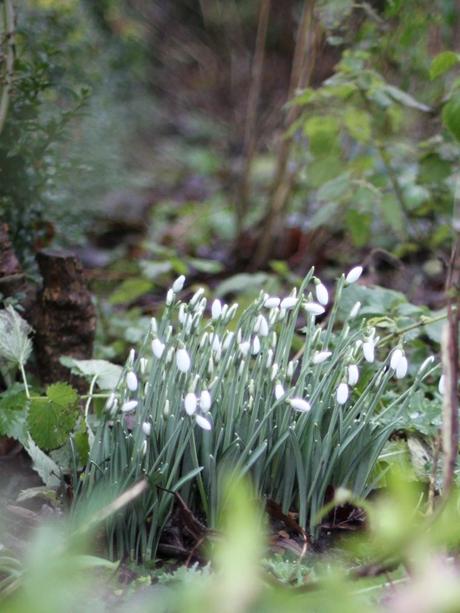 I do hope you have enjoyed this short look at one of my favourite flowers. It is so easy to let our spirits sink at this cold and dark point of the year but outside so much is happening - the garden is changing daily, it is time to start sowing the seeds of summer and the birds are beginning their flurry of activity as they prepare for nesting. For now I am happy to hold onto winter a little longer with fires and candles, good books and Netflix on the long dark evenings. During the days I am spending as much time as possible outdoors appreciating the beauty of the snowdrops in their brief season. Outside of my garden my favourite spot to see snowdrops is the lane that runs alongside my house where there are carpets of snowdrops running along the hedgerow and up the drive to the Manor House - mixed with a generous sprinkling of tiny yellow aconites this is a sight not to be missed at this time of year. I also like to plan a visit to Anglesey Abbey in February to enjoy the beautiful Winter Walk there, which always fills me with inspiration. Where do you like to visit in February - do share your favourite places please!Julie x
I do hope you have enjoyed this short look at one of my favourite flowers. It is so easy to let our spirits sink at this cold and dark point of the year but outside so much is happening - the garden is changing daily, it is time to start sowing the seeds of summer and the birds are beginning their flurry of activity as they prepare for nesting. For now I am happy to hold onto winter a little longer with fires and candles, good books and Netflix on the long dark evenings. During the days I am spending as much time as possible outdoors appreciating the beauty of the snowdrops in their brief season. Outside of my garden my favourite spot to see snowdrops is the lane that runs alongside my house where there are carpets of snowdrops running along the hedgerow and up the drive to the Manor House - mixed with a generous sprinkling of tiny yellow aconites this is a sight not to be missed at this time of year. I also like to plan a visit to Anglesey Abbey in February to enjoy the beautiful Winter Walk there, which always fills me with inspiration. Where do you like to visit in February - do share your favourite places please!Julie x  Insert your profile info here, by going to Users -> Your Profile -> Biographical Info. Profile image (avatar) comes from gravatar.com. Lorem ipsum dolor sit amet, consectetur adipiscing elit. Nullam faucibus ornare lectus nec cursus. early flower, 1660's, galanthus from the Greek meaning milk white flower, nivalis from the meaning resembling snow. From the Etymology Dictionary
Insert your profile info here, by going to Users -> Your Profile -> Biographical Info. Profile image (avatar) comes from gravatar.com. Lorem ipsum dolor sit amet, consectetur adipiscing elit. Nullam faucibus ornare lectus nec cursus. early flower, 1660's, galanthus from the Greek meaning milk white flower, nivalis from the meaning resembling snow. From the Etymology Dictionary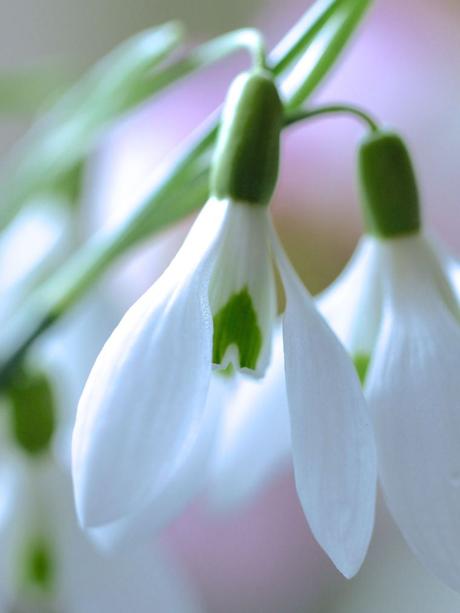
'If Candlemas Day is clear and bright
winter will have another bite.
If Candlemas Day brings cloud and rain
winter is gone and will not come again.'
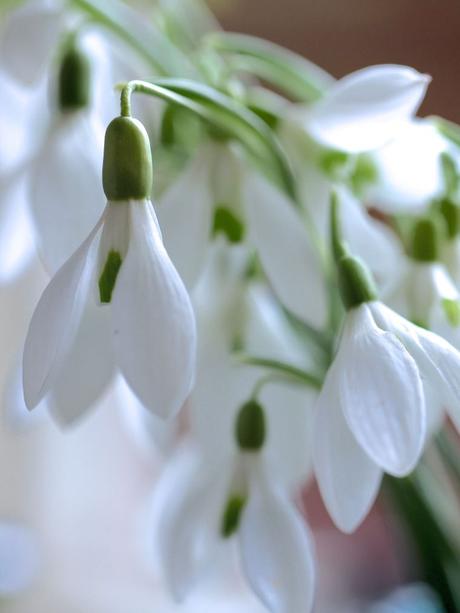 Today, February 2nd, is Candlemas Day in the church calendar - the day of Mary's purification, the presentation of Jesus in the Temple and the day on which the candles that are to be used in the next year of church services are blessed. In times gone by it was the custom to place a lighted candle in every window on Candlemas Day to bring light to the long dark winter - a tradition I think we would do well to revive today.Candlemas is also the day on which we are told we can predict the end of winter. Here in Suffolk, Candlemas has brought both cloud and rain, along with some very chilly temperatures. As I write tonight the fire is burning, my fairy lights are bringing a twinkling glow to the room and outside it is wet and chilly. After some refreshingly spring like days earlier this week I am holding out for the prediction that the worst is now behind us and spring is on its way. Looking at the actual forecast for next week however this seems very unlikely - I am keeping my fingers crossed that there will be some truth in the rhythm!
Today, February 2nd, is Candlemas Day in the church calendar - the day of Mary's purification, the presentation of Jesus in the Temple and the day on which the candles that are to be used in the next year of church services are blessed. In times gone by it was the custom to place a lighted candle in every window on Candlemas Day to bring light to the long dark winter - a tradition I think we would do well to revive today.Candlemas is also the day on which we are told we can predict the end of winter. Here in Suffolk, Candlemas has brought both cloud and rain, along with some very chilly temperatures. As I write tonight the fire is burning, my fairy lights are bringing a twinkling glow to the room and outside it is wet and chilly. After some refreshingly spring like days earlier this week I am holding out for the prediction that the worst is now behind us and spring is on its way. Looking at the actual forecast for next week however this seems very unlikely - I am keeping my fingers crossed that there will be some truth in the rhythm! Whilst I have had snowdrops in flower since early January, I think of February as the best month for these dainty blooms. Alternatively know as Candlemas Bells and Fair Maids of February, it is now that the common snowdrop, galanthus nivalis, is appearing in carpets amongst the woodland areas of long established gardens and forests. This is the month to seek out the grand old houses with open gardens to enjoy the beautiful sight and scent of thousands of snowdrops flowering together. Even the likelihood of February snow will not daunt them - they are not known in France as perce-neige (snow piercers) for nothing. Coinciding with the very welcome spectacle of the snowdrops we also have the song of the blackbirds returning to our gardens - their first songs can be heard in late January or early February - another annual joy that marks the hope of the return to spring.
Whilst I have had snowdrops in flower since early January, I think of February as the best month for these dainty blooms. Alternatively know as Candlemas Bells and Fair Maids of February, it is now that the common snowdrop, galanthus nivalis, is appearing in carpets amongst the woodland areas of long established gardens and forests. This is the month to seek out the grand old houses with open gardens to enjoy the beautiful sight and scent of thousands of snowdrops flowering together. Even the likelihood of February snow will not daunt them - they are not known in France as perce-neige (snow piercers) for nothing. Coinciding with the very welcome spectacle of the snowdrops we also have the song of the blackbirds returning to our gardens - their first songs can be heard in late January or early February - another annual joy that marks the hope of the return to spring.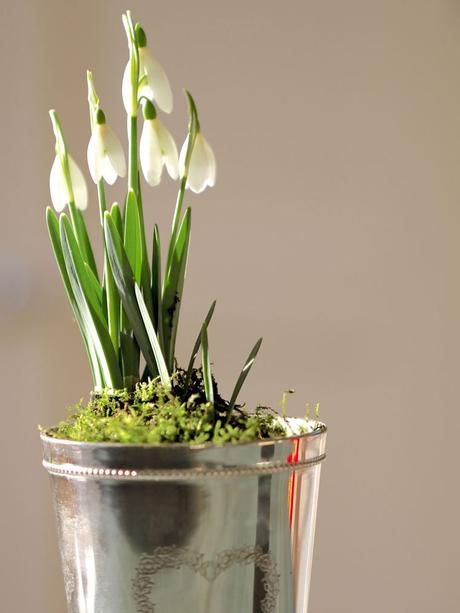 In a darker tradition snowdrops are known as the death flower. The Victorians believed that the snowdrop represented death and that it would bring bad luck to bring snowdrops inside. The snowdrop was, however, Prince Alberts favourite flower and Queen Victoria carried a small bouquet of snowdrops on their wedding day on 10th February 1840 - clearly she was not troubled by their sinister reputation. After her death on 22nd January 1901 her coffin was surrounded by white flowers which included snowdrops brought from Osborne House, the summer residence of Victoria and Albert on the Isle of White.
In a darker tradition snowdrops are known as the death flower. The Victorians believed that the snowdrop represented death and that it would bring bad luck to bring snowdrops inside. The snowdrop was, however, Prince Alberts favourite flower and Queen Victoria carried a small bouquet of snowdrops on their wedding day on 10th February 1840 - clearly she was not troubled by their sinister reputation. After her death on 22nd January 1901 her coffin was surrounded by white flowers which included snowdrops brought from Osborne House, the summer residence of Victoria and Albert on the Isle of White.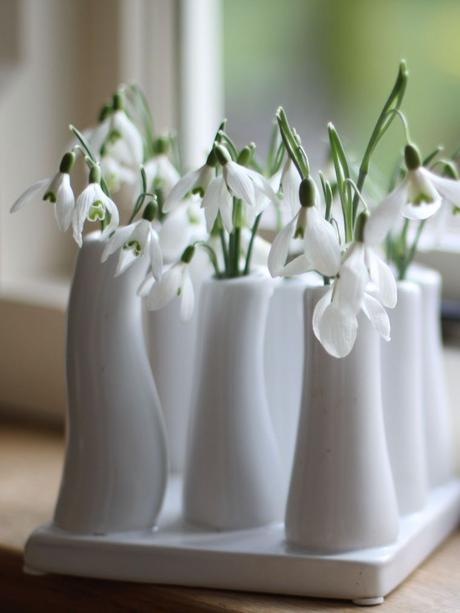 Personally I have no suspicions relating to any of the flowers that I can cut from my garden - all are loved and welcomed into my home. At this time of year rarely a day goes by when I do not have a little bunch of snowdrops cut to enjoy inside. Whilst it is a challenge not to spend time dreaming of spring and all the joys that it will bring, I am very conscious of the importance of enjoying what is here right now - the many snowdrops that are filling corners of my garden under deciduous trees, hellebores with their jewel like colours and the dancing catkins that are hanging from hazel, birch, hornbeam and alder trees and the beautiful shrub garrya 'James Roof'. When you add the joys of trailing ivy with its perfect berries, frosted topiary and a greenhouse filled with the scent of Paperwhites, February is clearly a month to embrace - all too quickly it will be over and the snowdrops will be just another item on my to do list - i.e. 'must divide clumps before the foliage dies away'.
Personally I have no suspicions relating to any of the flowers that I can cut from my garden - all are loved and welcomed into my home. At this time of year rarely a day goes by when I do not have a little bunch of snowdrops cut to enjoy inside. Whilst it is a challenge not to spend time dreaming of spring and all the joys that it will bring, I am very conscious of the importance of enjoying what is here right now - the many snowdrops that are filling corners of my garden under deciduous trees, hellebores with their jewel like colours and the dancing catkins that are hanging from hazel, birch, hornbeam and alder trees and the beautiful shrub garrya 'James Roof'. When you add the joys of trailing ivy with its perfect berries, frosted topiary and a greenhouse filled with the scent of Paperwhites, February is clearly a month to embrace - all too quickly it will be over and the snowdrops will be just another item on my to do list - i.e. 'must divide clumps before the foliage dies away'.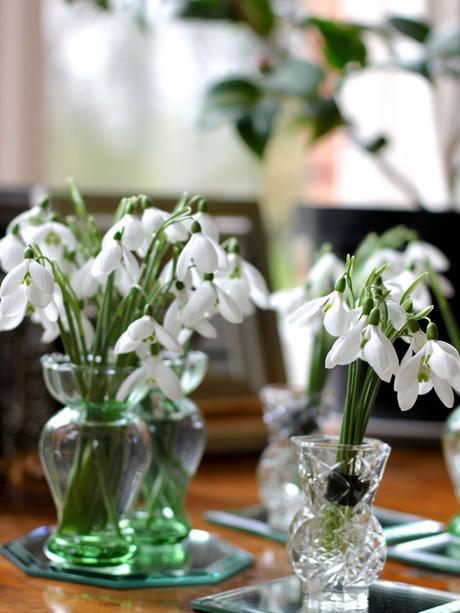 Whilst I do appreciate the galanthophile's passion for the various named varieties of snowdrops and the long flowering period that can extend from autumn well into spring, I have to admit that I do not share in this passion to collect unusual bulbs. For me the sight and scent of the mass flowering of the common single galanthus nivalis and double flore pleno in February provides all the romance and beauty that I seek. I often wonder how the red rose that has to be imported from warmer climates became the symbol of Valentines Day, when the fleeting beauty of these delicate snowdrops would represent love in this wintery season so much better.
Whilst I do appreciate the galanthophile's passion for the various named varieties of snowdrops and the long flowering period that can extend from autumn well into spring, I have to admit that I do not share in this passion to collect unusual bulbs. For me the sight and scent of the mass flowering of the common single galanthus nivalis and double flore pleno in February provides all the romance and beauty that I seek. I often wonder how the red rose that has to be imported from warmer climates became the symbol of Valentines Day, when the fleeting beauty of these delicate snowdrops would represent love in this wintery season so much better.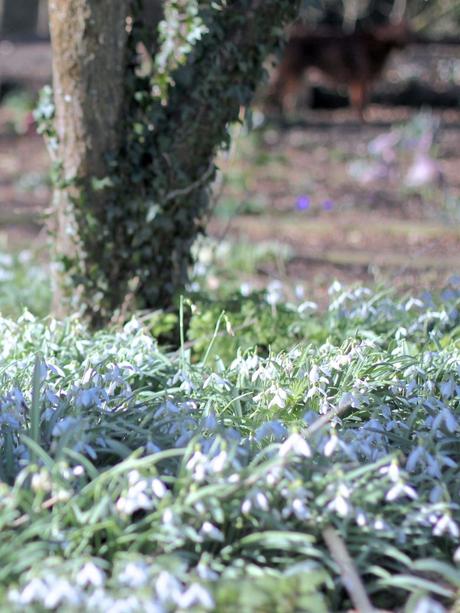 Snowdrops make a beautiful pairing with hellebores in the winter garden - both reach their peek of beauty at about the same time and enjoy much the same growing conditions. I wrote about my love of hellebores a couple of weeks ago - you can visit that post here - and since then I have added yet more varieties to my Spring Walk. Around the new hellebores I will be planting divided clumps of my snowdrops after they have finished flowering in March as nothing hides the bare soil surrounding a hellebore better than a skirt of snowdrops.
Snowdrops make a beautiful pairing with hellebores in the winter garden - both reach their peek of beauty at about the same time and enjoy much the same growing conditions. I wrote about my love of hellebores a couple of weeks ago - you can visit that post here - and since then I have added yet more varieties to my Spring Walk. Around the new hellebores I will be planting divided clumps of my snowdrops after they have finished flowering in March as nothing hides the bare soil surrounding a hellebore better than a skirt of snowdrops.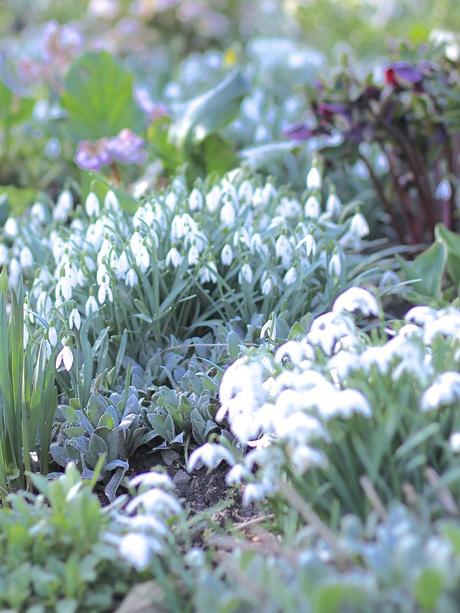 I have been blessed with a garden in this old rectory that is full of snowdrops, many growing in grass under trees in otherwise quiet corners that I only actively seek out at this time of year. Old Rectorys, like churchyards and monasteries are often blessed with huge swathes of snowdrops - were they planted in these religious places because their flowering time coincides with Candlemas I wonder, or were they already there in flower before these places were built and were protected and allowed to increase because their flowering coincided with Candlemas? In my developing Spring Walk where I grow the majority of my hellebores I am trying to increase the areas populated by snowdrops, so every year I devote a day or two to lifting and splitting clumps of bulbs. The smaller clumps are replanted under trees, shrubs and hellebores in this area with a handful of fish, blood & bone to help them recover from the ordeal of being moved. I have read that Beth Chatto did this every year in her beautiful garden and that is why her snowdrop display is so extensive today.
I have been blessed with a garden in this old rectory that is full of snowdrops, many growing in grass under trees in otherwise quiet corners that I only actively seek out at this time of year. Old Rectorys, like churchyards and monasteries are often blessed with huge swathes of snowdrops - were they planted in these religious places because their flowering time coincides with Candlemas I wonder, or were they already there in flower before these places were built and were protected and allowed to increase because their flowering coincided with Candlemas? In my developing Spring Walk where I grow the majority of my hellebores I am trying to increase the areas populated by snowdrops, so every year I devote a day or two to lifting and splitting clumps of bulbs. The smaller clumps are replanted under trees, shrubs and hellebores in this area with a handful of fish, blood & bone to help them recover from the ordeal of being moved. I have read that Beth Chatto did this every year in her beautiful garden and that is why her snowdrop display is so extensive today.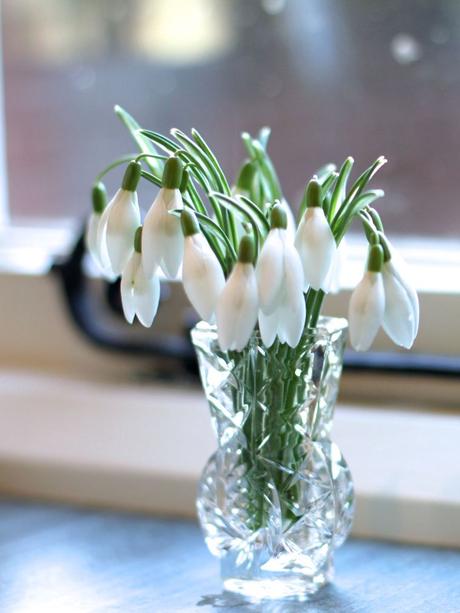 It is important not to plant snowdrops under evergreen trees - the permanent deep shade from these trees does not suit these tiny bulbs and they will be unlikely to survive - they are also not good in very wet situations. A woodland setting or the edges of a deciduous hedge are the ideal position. They will also do well in a partially shaded border. If you are splitting existing clumps I would advise that you replant the bulbs in a random manner - spacing small groups of bulbs deep into the border to give a feeling of depth. All too often snowdrops can be seen just edging a border in a manner that is most unnatural - in nature they spread themselves in pools rather than lines and to my eye this natural way is best. Current thinking suggests that it is best to split the clumps whilst the bulbs are completely dormant but this would only work in a garden where clumps are individualy marked year round. It is far more practical for me to split the bulbs 'in the green' as I have done for many years, when I can clearly see where they are and the impact that any new plantings will have on the border at the time that the snowdrops are to flower.
It is important not to plant snowdrops under evergreen trees - the permanent deep shade from these trees does not suit these tiny bulbs and they will be unlikely to survive - they are also not good in very wet situations. A woodland setting or the edges of a deciduous hedge are the ideal position. They will also do well in a partially shaded border. If you are splitting existing clumps I would advise that you replant the bulbs in a random manner - spacing small groups of bulbs deep into the border to give a feeling of depth. All too often snowdrops can be seen just edging a border in a manner that is most unnatural - in nature they spread themselves in pools rather than lines and to my eye this natural way is best. Current thinking suggests that it is best to split the clumps whilst the bulbs are completely dormant but this would only work in a garden where clumps are individualy marked year round. It is far more practical for me to split the bulbs 'in the green' as I have done for many years, when I can clearly see where they are and the impact that any new plantings will have on the border at the time that the snowdrops are to flower.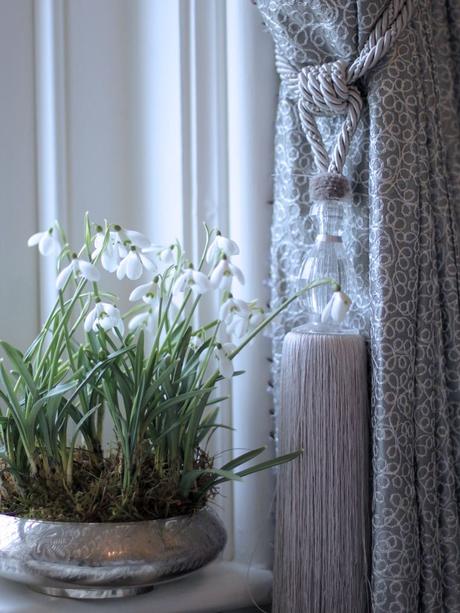 Sometimes I will lift a clump whilst it is still in flower and replant the bulbs in an indoor container - this silver bowl is a favourite. The flowers will last a little longer than they do if cut for a vase, but the bulbs must be kept in a cool room - snowdrops are a flower of the winter after all - and the flowers will brown very quickly in a warm situation. In truth, however pretty these indoor vignettes are, snowdrops are happiest out in the garden where they will flower for weeks until a warm spring day towards the end of February will send them retreating back to the safety of the soil for the summer months, waiting their turn to shine again next winter. As with all bulbs, do not remove the leaves until they have turned brown and come away easily. In areas where they are growing through the grass, I have a strict rule of not cutting the grass until May to allow the bulbs time to replenish themselves before their leaves are removed.
Sometimes I will lift a clump whilst it is still in flower and replant the bulbs in an indoor container - this silver bowl is a favourite. The flowers will last a little longer than they do if cut for a vase, but the bulbs must be kept in a cool room - snowdrops are a flower of the winter after all - and the flowers will brown very quickly in a warm situation. In truth, however pretty these indoor vignettes are, snowdrops are happiest out in the garden where they will flower for weeks until a warm spring day towards the end of February will send them retreating back to the safety of the soil for the summer months, waiting their turn to shine again next winter. As with all bulbs, do not remove the leaves until they have turned brown and come away easily. In areas where they are growing through the grass, I have a strict rule of not cutting the grass until May to allow the bulbs time to replenish themselves before their leaves are removed.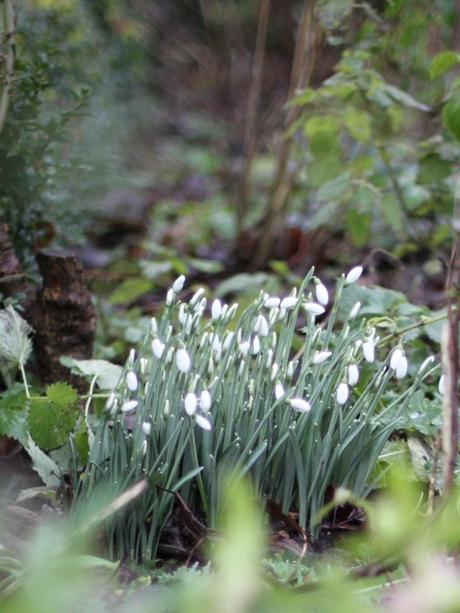 I do hope you have enjoyed this short look at one of my favourite flowers. It is so easy to let our spirits sink at this cold and dark point of the year but outside so much is happening - the garden is changing daily, it is time to start sowing the seeds of summer and the birds are beginning their flurry of activity as they prepare for nesting. For now I am happy to hold onto winter a little longer with fires and candles, good books and Netflix on the long dark evenings. During the days I am spending as much time as possible outdoors appreciating the beauty of the snowdrops in their brief season. Outside of my garden my favourite spot to see snowdrops is the lane that runs alongside my house where there are carpets of snowdrops running along the hedgerow and up the drive to the Manor House - mixed with a generous sprinkling of tiny yellow aconites this is a sight not to be missed at this time of year. I also like to plan a visit to Anglesey Abbey in February to enjoy the beautiful Winter Walk there, which always fills me with inspiration. Where do you like to visit in February - do share your favourite places please!Julie x
I do hope you have enjoyed this short look at one of my favourite flowers. It is so easy to let our spirits sink at this cold and dark point of the year but outside so much is happening - the garden is changing daily, it is time to start sowing the seeds of summer and the birds are beginning their flurry of activity as they prepare for nesting. For now I am happy to hold onto winter a little longer with fires and candles, good books and Netflix on the long dark evenings. During the days I am spending as much time as possible outdoors appreciating the beauty of the snowdrops in their brief season. Outside of my garden my favourite spot to see snowdrops is the lane that runs alongside my house where there are carpets of snowdrops running along the hedgerow and up the drive to the Manor House - mixed with a generous sprinkling of tiny yellow aconites this is a sight not to be missed at this time of year. I also like to plan a visit to Anglesey Abbey in February to enjoy the beautiful Winter Walk there, which always fills me with inspiration. Where do you like to visit in February - do share your favourite places please!Julie x  Insert your profile info here, by going to Users -> Your Profile -> Biographical Info. Profile image (avatar) comes from gravatar.com. Lorem ipsum dolor sit amet, consectetur adipiscing elit. Nullam faucibus ornare lectus nec cursus.
Insert your profile info here, by going to Users -> Your Profile -> Biographical Info. Profile image (avatar) comes from gravatar.com. Lorem ipsum dolor sit amet, consectetur adipiscing elit. Nullam faucibus ornare lectus nec cursus.
